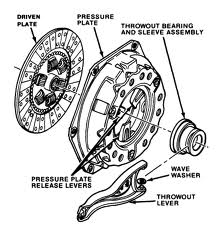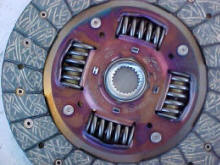Clutch problems? Contact us with any questions, Wayne's Garage can Service or Replace your clutch as necessary.
Automotive Clutch - How it works
Cars with manual transmissions use a clutch to engage and disengage the transmission from the engine. The typical clutch setup consists of a flywheel that connects to the engine, a clutch disc that is splined to the transmission input shaft and a pressure plate bolted to the flywheel. The clutch disc is a covered on both sides with a friction material similar to what is used for brake shoes. The clutch disc is sandwiched between the flywheel and the pressure plate.

When your foot is off the pedal, diaphragm springs push the pressure plate against the clutch disc, which in turn presses against the flywheel. This locks the engine to the transmission input shaft, causing them to spin at the same speed. Friction between the disc and the two surfaces while pressing and releasing the pedal allow a smooth transition during engagement.
The amount of force the clutch can hold depends on the friction between the clutch plate and the flywheel, and how much force the spring puts on the pressure plate.

When the clutch pedal is pressed, a cable or hydraulic piston pushes on the release fork, which presses the throw-out bearing against the middle of the diaphragm spring. As the middle of the diaphragm spring is pushed in, a series of pins near the outside of the spring causes the spring to pull the pressure plate away from the clutch disc This releases the clutch from the spinning engine.
When replacing the clutch always replace the pressure plate as they lose tension over time due to heat and wear, the release or throwout bearing which disengages the clutch and the pilot bearing or bushing (if used) which supports the transmission input shaft.
The flywheel should be machined flat to give good contact and prevent grabbing and premature failure.
Clutch "grabbing" is when the clutch is jerky as it is releasing. This can be caused by oil on the clutch, weak or warped pressure plate or burned or worn clutch material.

Clutch Disc - friction material with dampening springs. Center splines onto transmission input shaft.
To replace a clutch the transmission or engine is removed for access. On some vehicles especially 4WD or all wheel drive vehicles this can be a difficult and time consuming repair.
Many newer higher performance car applications and trucks are using Dual Mass flywheels which are designed to transmit less engine vibration to the driveline, and give a better smoother driving experience. They also reduce some of the jarring and stress on the transmission and remainder of the drivetrain. These flywheels wear out and usually need to be replaced with the clutch which really can drive up the price of clutch repair.
Most clutches today are activated hydraulically using a master cylinder similar to what is used with the brakes and a slave cylinder which pushes on the clutch fork when the pedal is depressed. Older cars may use a cable to pull on the fork.
Hydraulic problems are often diagnosed as a bad clutch.
Wayne's Garage Auto Repair
Auto Service for Eugene and Springfield
333 Q Street in Springfield

